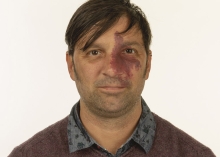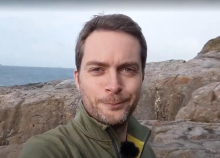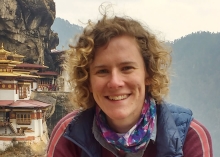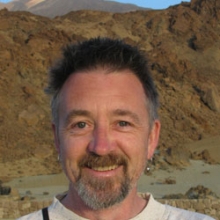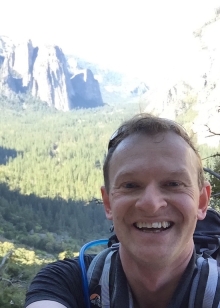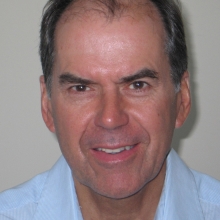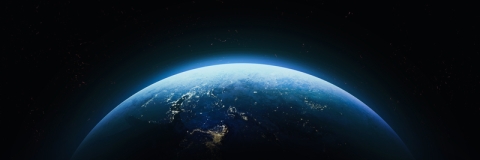

Crustal Evolution and Tectonics Research Group
Uncovering the earth's tectonic history and impacts
At Portsmouth our group is particularly focussed on the development of Plate Tectonics throughout Earth history. We are addressing fundamental questions with respect to the Earth system such as when did Plate Tectonics begin operating and what changes can be documented in the style and rate of plate movement and subduction through time.
Most people are satisfied that some form of Plate Tectonics has been occurring since the Archaean, but how different was it to the modern observable record and when and how did we change from the ancient mode to the modern? Alongside that we are interested in documenting the rate of continental crustal growth and recycling through time and how any changes in tectonics have influenced the rates of crustal growth and preservation. These are fundamental challenges underpinning all we know about our dynamic planet and perhaps others. We also work on meteorites and impact craters; in particular methods for dating meteorite formation and their arrival on Earth via accessory minerals and their shocked features.
These processes, and their secular change, undoubtedly govern many other variables. Of great consideration are the origins of atmospheric oxygen and, therefore, the evolution of life on Earth together with its controls of Earth’s climate system. Related to this is the influence of tectonics on ocean circulation and weathering, particularly with its control on CO2 drawdown to the deep oceans.
Research topics
Although the Earth is c.4.6 Ga, the extant record of the continental crust only stretches back to ~4.0 Ga, and is rare until ~3.0 Ga (e.g. Campbell and Allen, 2008), corresponding to the onset of ‘modern’ plate tectonics (e.g. Dhuime et al, 2012). To interrogate the crustal record across this critical period in Earth’s history, we must complement the extant rock record with detrital minerals preserved in younger rocks.
However, there are two key difficulties with this approach. First, we need a way to determine the source (provenance) of these detrital minerals, which requires the basement rocks in the suggested source areas to be well-characterised. Second, since the continental crust develops in at least two stages, we need minerals representative of each stage to fully understand its development, and changes in the processes involved.
High-pressure rocks are notoriously difficult to preserve within the rock record due to metastability. Whilst medium to high temperature eclogites are present back to the Archaean, suggesting thickened crust, blueschists are only present back to the Neopropterozoic around 800 Ma ago. The latter are of extreme importance since they are indicative of the modern observable mode of plate tectonics, that is steep and deep subduction of oceanic crust resulting in lowered geotherms in benioff zones and consequent low temperature, high pressure metamorphism. Equally, the oldest records of ultrahigh pressure metamorphism, from rapid ultradeep subduction and exhumation of continental crust, only extends back as far as possibley c.600 Ma ago. Our research attempts to use new methods via the accessory mineral rutile (TiO2) to test whether this situation is based on preservation or is refelective of the thermal evolution of Earth.
We are studying ancient climate systems in an effort to better understand modern climate issues and to predict future climate change. The Mid-Pliocene is the most recent time in Earth's history when mean global temperatures were substantially warmer than today with a climate similar to that predicted for the end of this century if we continue to burn fossil fuels at the current rate. Thus, there is potential for using the Mid-Pliocene as an analogue for future global warming and testing the veracity of climate models.
We will achieve this greater understanding by examining sand sized grains from 3 million year old deep ocean sediments from the North Atlantic so we can get an estimate of which areas were covered in ice at that time. This reconstruction can then be compared to existing model results to examine their performance. This will help inform our level of confidence in their predictions of the behaviour of the Greenland ice sheet in the future.
Understanding their petrogenesis and tectonic significance of sanukitoids is crucial to informing the debate about when Earth began experiencing plate tectonics in a fashion that we can understand from modern observations, with steep subduction of oceanic crust, paired metamorphic belts, recycling of sediments into the mantle and the generation of large volumes of magma within arcs and back-arcs. Phanerozoic analogues of sanukitoids are well-exposed in the Scottish Highlands and known as high Ba-Sr granites. Our research is studying the petrogenesis of these granites as well as Neoarchaean sanukitoids from Finland.
We are exploring the microchemistry of accessory minerals in order to establish a recognisable “sanukitoid fingerprint”, which might then be sought in the detrital mineral record. If successful, we will be in a position to quantify the global significance of such magmatism over geological time.
The supercontinent Rodinia formed at 1.1-1.0 Ga by the amalgamation of Laurentia, Baltica and Amazonia. Recent continental reconstructions imply that East Greenland, Svalbard and Scotland were close to an active plate margin along the edge of the supercontinent. Previously enigmatic orogenic events in the time span 950-750 Ma in these areas are now interpreted in terms of a newly-recognised accretionary orogen (the Valhalla orogen of Cawood et al. 2010). Current research in NW Scotland and in the Shetland Islands is aimed at integrating sedimentological, geochronological, petrological, geochemical and isotopic studies of these complex polymetamorphic rocks in an attempt to build up a clearer picture of the evolution of this orogenic tract. This is no trivial matter since all the areas affected by Neoproterozoic orogenic events have been strongly overprinted by Lower Palaeozoic Caledonian orogenesis. This has resulted in widespread reworking of Neoproterozoic metamorphic assemblages which may only be preserved in the cores of large porphyroblasts. New research interprets the sedimentary fill of the Morar Group basin as developing in the foreland of the c. 1 Ga Grenville orogen near to the periphery of the Rodinia supercontinent.
Models for Caledonian orogenic events in Northern Scotland involve Grampian (480-465 Ma) deformation and metamorphism (arc-continent collision), followed by ductile reworking during the Scandian (435-425 Ma) event (Laurentia-Baltica collision). This model is being tested and refined by detailed structural and petrological studies and U-Pb geochronology aimed at understanding: 1) the deformational and metamorphic fabrics that formed within the mid-crust during these orogenic events (e.g. Krabbendam et al. 2011), 2) the generation, emplacement mechanism and structural settings of pre- and syn-orogenic intrusions that can be used as time-markers (e.g. Goodenough et al. 2011), 3) the large-scale tectonic significance of different kinematic regimes, in particular the relative timing of thrusting and strike-slip displacements, 4) the relationships between regional Barrovian metamorphism and ophiolite emplacement (Cutts et al. 2011).
Since continents are largely granitic, detailed understanding of granitoid petrogenesis is vital in understanding continent evolution. Further, granitoid magmatism can be the product of various partial melting regimes in many tectonic settings, from fractionated mantle-derived melts in subduction zones, oceanic or continental rifts to the anatectic products of crustal materials in evolving orogens. Detailed investigations into their geochemistry can therefore be used to constrain the tectonic regime responsible for their generation.
Granitoid plutons and associated magmatism in northwest Britain have been related to various stages of the Caledonian orogenic event including pre-collisional subduction of the Iapteus plate and post-collisional slab break-off. The present study aims to investigate the geochemistry of a series of granitoid and diorite plutons in western Shetland. Limited age data constrain magmatism to around 360 Ma, which is considerably younger than other plutons occurring along strike of the Great Glen fault in Scotland and Ireland. Work is in progress to determine the petrogenesis and geochronology of the plutons in respect of continuing slab break-off or if they were the products of transtensional basins developed in response to movement along the Great Glen fault.
Metamorphic complexes occur in various tectonic settings all over the world and a range of models has been proposed to explain both the metamorphism itself and the subsequent exhumation to the surface. The Chugach Metamorphic Complex (CMC) of south-eastern Alaska is an elongate zone of high-grade schists and migmatites within a paleoaccretionary prism exhumed between major strike-slip and thrust faults.
The aim of this project is to characterize in detail variations in metamorphic grade across the complex and determine the exact timing of heating, peak metamorphism, cooling and exhumation. With these data we hope to solve a part of the geological puzzle that lead to the presence of the Chugach Metamorphic Complex develop in a forearc location.
Meteorites from the Moon, Mars and the asteroid belt offer tremendous insights into the evolution of our Solar System, and key events in Earth's history. They bear witness to the formation and differentiation of planets, as well as the intensive bombardment of planetary surfaces during the first ∼1 billion years of Earth's history. Current research in these areas combines the study of large meteorite impact structures on Earth, with the investigation of meteorites from across the Solar System. By integrating field observations, petrology and state-of-the-art techniques for characterising the structure and chemistry of samples at the micro- to nano-scale, we are developing a greater understanding of the effects of large meteorite impacts on planetary crusts (e.g. Darling et al., 2011, EPSL), as well as how we can better resolve the primary crystallisation ages of meteorites from the timing of impact disturbance (e.g. Moser et al., 2013, Nature).
Economic deposits of natural resources are influenced by a vast range of lithospheric processes, including magmatism, orogenesis and hydrothermal activity. Understanding the genetic linkages between these processes, and how they may have changed throughout Earth's history, is essential for the development of new process-based exploration models. Our research focuses upon developing and applying new isotopic and microstructural tools to date tectonic and ore-forming events (e.g. Darling et al., 2012, Chem. Geol.), as well as track metal cycling and sediment provenance (e.g. Darling et al., 2012, GCA). These tools are being applied to a range of problems, including the mobilisation of Ni-Cu-PGE ores in orogenic events, the development of sedimentary basins that contain major hydrocarbon reserves, and the origin of deposits of metals that are critical to sustainable technologies.
Publications
-
The shocking state of apatite and merrillite in shergottite Northwest Africa 5298 and extreme nanoscale chlorine isotope variability revealed by atom probe tomography
Darling, J., White, L., Kizovski, T., Černok, A., Moser, D. E., Tait, K., Dunlop, J. N., Langelier, B., Douglas, J., Zhao, X., Franchi, I. & Anand, M., 1 Jan 2021, In: Geochimica et Cosmochimica Acta. 293, p. 422-437
-
The metamorphic and magmatic record of collisional orogens
Weller, O. M., Mottram, C. M., St-Onge, M. R., Möller, C., Strachan, R., Rivers, T. & Copley, A., 19 Oct 2021, In: Nature Reviews Earth & Environment. 2, p. 781-799
-
Earth’s new tectonic regime at the dawn of the Paleoproterozoic: Hf isotope evidence for efficient crustal growth and reworking in the São Francisco Craton, Brazil
Bruno, H., Heilbron, M., Strachan, R., Fowler, M., De Morisson Valeriano, C., Bersan, S., Moreira, H. S., Cutts, K., Dunlop, J. N., Almeida, R. & Storey, C., 1 Oct 2021, In: Geology. 49, 10, p. 1214–1219
-
Deformation controlled Long-Period seismicity in low-cohesion volcanic sediments
Rowley, P., Benson, P. & Bean, C. J., 1 Dec 2021, In: Nature Geoscience. 14, p. 942-948
-
Detrital rutile: Records of the deep crust, ores and fluids
Detrital rutile: Records of the deep crust, ores and fluids Pereira, I. & Storey, C. D., 1 Feb 2023, In: Lithos. 438-439, 20 p., 107010.
-
Accessory mineral constraints on crustal evolution: elemental fingerprints for magma discrimination
Bruand, E., Fowler, M., Storey, C., Laurent, O., Antoine, C., Guitreau, M., Heilimo, E. & Nebel, O., 26 Feb 2020, In: Geochemical Perspectives Letters . 13, p. 7-12 6 p.
-
Tectonic significance of a supra-ophiolitic sedimentary cover succession, Unst, Shetland, Scottish Caledonides: insights from the U-Pb-Hf detrital zircon record
Papapavlou, K., Strachan, R. A., Storey, C. D. & Bullen, D., 1 Sept 2021, In: Journal of the Geological Society. 178, 5, 14 p., jgs2020-169.
-
A new stratigraphic framework for the early Neoproterozoic successions of Scotland
Krabbendam, M., Strachan, R. & Prave, T., 1 Mar 2022, In: Journal of the Geological Society. 179, 2, 16 p., jgs2021-054.
Projects
-
Purchase of a Tandem LA-LIBS femtosecond laser for the UK
-
ICASE: Icelandic Continental Analogue for Sialic Evolution
-
Heavy-element stable isotope constraints on ancient subduction chemical dynamics
-
Enzyme-Enhanced Carbon Capture Storage Solutions in Basaltic Rock
-
The petrogenesis of Virgin Island granitoids: Implications for crustal growth on the early Earth
-
Investigating timing of gold mineralisation along strategic faults in the Yukon, Arctic Cordillera
-
UK Leadership in Extraterrestrial sample return
-
Geological safety and optimisation in mining operations: towards a new understanding of fracture damage, heterogenity and anisotropy
Facilities
The University is home to exceptional facilities, where much of our research takes place, including:
- Two laser systems (ASi Resolution 193nm excimer and Applied Spectra J200 femtosecond with tandem LIBS) – a Nu Plasma MC-ICPMS and an Agilent 8900 triple quadrupole ICP-MS
- Two Zeiss Evo SEMs, one with a LaB6 source and tungsten. Our LaB6 instrument is equipped with Oxford Instruments EBSD, EDS BE and CL detectors. One Tescan FEG SEM with Oxford Intruments EDS and BE detectors. We specialise in nano- to micro-scale imaging and crystallography of a range of earth materials
- Two X-ray facilities – a Rigaku WD-XRF and a Panalytical XRD, which can analyse most elements and a wide-range of matrices, both solid and liquid

